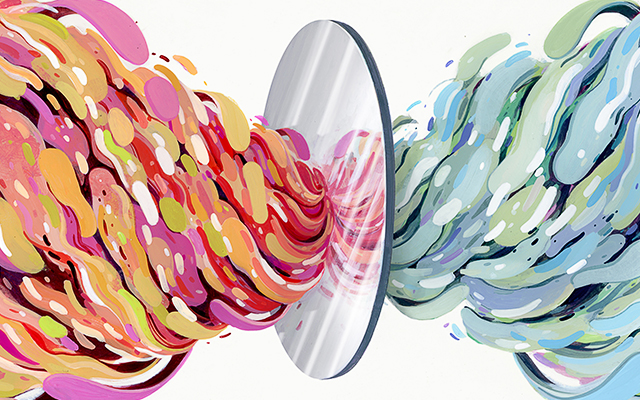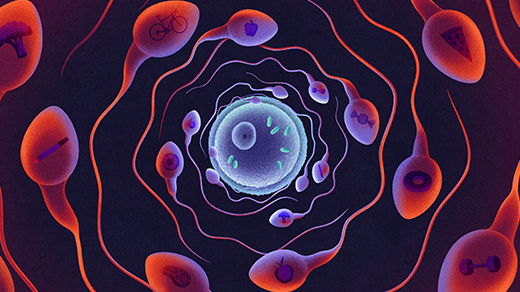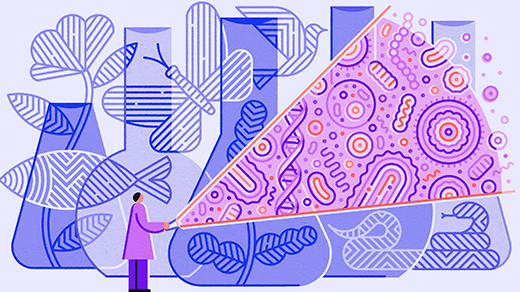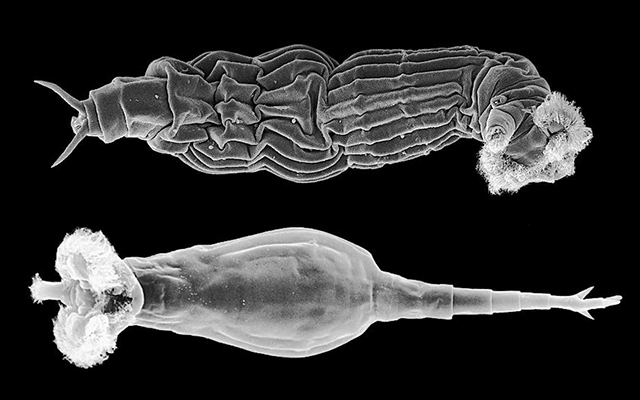New Twist Found in the Story of Life’s Start

For 30 years, Gerald Joyce has been trying to create life. As a graduate student in the 1980s, he studied how the first RNA molecules — chemical cousins to DNA that can both store and transmit genetic information — might have assembled themselves out of simpler units, a process that many scientists believe led to the first living things.
Unfortunately, he had a problem. At a chemical level, a deep bias permeates all of biology. The molecules that make up DNA and other nucleic acids such as RNA have an inherent “handedness.” These molecules can exist in two mirror image forms, but only the right-handed version is found in living organisms. Handedness serves an essential function in living beings; many of the chemical reactions that drive our cells only work with molecules of the correct handedness. But the pre-biological building blocks of life didn’t exhibit such an overwhelming bias. Some were left-handed and some right. So how did right-handed RNA emerge from a mix of molecules?
Joyce was able to build RNA out of right-handed building blocks, as others had done before him. But when he added in left-handed molecules, mimicking the conditions on the early Earth, everything came to a halt. “Our paper said if you have [both] forms in the same place at the same time, you can’t even get started,” Joyce said.
His findings, published in Nature in 1984, suggested that in order for life to emerge, something first had to crack the symmetry between left-handed and right-handed molecules, an event biochemists call “breaking the mirror.” Since then, scientists have largely focused their search for the origin of life’s handedness in the prebiotic worlds of physics and chemistry, not biology.
Three decades later, Joyce’s latest research has shown that perhaps life came first after all. Joyce, now at the Scripps Research Institute in La Jolla, Calif., and Jonathan Sczepanski, a postdoctoral researcher, created an RNA enzyme — a substance that copies RNA — that can function in a soup of left- and right-handed building blocks, providing a potential mechanism for how some of the first biological molecules might have evolved in a symmetrical world. The new experiment, published in the November 20 issue of Nature, is reinvigorating the discussion over how life first arose. “They have really opened up a new realm of possible roads,” said Niles Lehman, a biochemist at Portland State University in Oregon who wasn’t involved in the study.
Even more intriguing, Joyce and Sczepanski’s enzyme works differently from other RNA-copying molecules, a discovery that may have profound implications for how life originated. The enzyme is much more efficient and flexible than other RNA-based enzymes developed to date, and it may provide the key to Joyce’s ultimate goal — making life from scratch.
A Crack in the Mirror
Louis Pasteur, the famous 19th-century French chemist, was the first to describe chemical handedness, or “chirality.” He was puzzled by the fact that crystals derived from the dregs of wine twisted light in a specific direction, but the same crystal synthesized in the lab did not. Examining the crystals under a microscope, he discovered that the synthetic chemical came in two mirror-image forms, which canceled out the polarizing effect. The crystal derived from wine had only one.
Scientists later discovered that this bias encompasses the entire living world. Synthetic chemical processes will generate both left- and right-handed molecules. But when nature makes a molecule, the product is either left- or right-handed. For example, all amino acids that are used to make proteins twist light to the left.
Indeed, chirality is an essential component of biochemistry. “It provides a form of molecular recognition,” said Donna Blackmond, a chemical engineer at Scripps and a colleague of Joyce’s. The chirality of a molecule affects how it interacts with other components of the cell. Molecular locks can only be opened with a key of the correct handedness.
Some scientists look to the heavens to explain how this biological bias first arose. Some meteorites show a slight predominance of left-handed amino acids, the building blocks of proteins, suggesting that the influence came from outer space. An alternative cosmic origin story proposes that circularly polarized light coming from a supernova triggered a bias. In addition, radioactive decays produce electrons that are slightly more likely to be left-handed. Such electrons raining down on Earth’s surface might have changed its early chemistry.
Yet most biologists and chemists are skeptical of these astrophysical theories. The bias they create is just too minute. The theories create “a beautiful union between life and nonlife,” said Marcelo Gleiser, a theoretical physicist at Dartmouth College. “But the problem is that those interactions are very weak and short-range.” According to Joyce, the effect of these physical forces would be lost in the noise of chemical reactions. “Such a small asymmetry in the universe is not enough to move the needle,” he said.
Biochemists have tended to favor an alternative proposal, that a chance occurrence of prebiotic chemistry triggered an initial disequilibrium. Perhaps a slight excess of right-handed nucleotides was trapped and amplified in a shallow pool or some other prebiotic test tube. Eventually the bias reached a tipping point, breaking the chemical mirror and setting the stage for the emergence of life. Blackmond has done extensive work showing how to transform a small asymmetry to a nearly complete one using purely physical and chemical means.
Shaking Both Hands
When Joyce entered the field 30 years ago, researchers were already trying to test some of the astrophysical theories. But Joyce was skeptical. “I thought, why are you trying so hard to find a universal explanation when it’s probably chance?” he said.
Around the same time, scientists were trying to figure out how the building blocks of life — amino acids and nucleic acids — could have spontaneously formed into more complex molecules such as proteins, DNA and RNA. Joyce thought that this assembly process might generate a crack in the mirror. A reaction that selectively plucked right-handed building blocks from the primordial soup would quickly start to create only right-handed molecules, just as a machine that selects only red or only blue Legos from a mixed box would create single-colored towers.
Such a process would simultaneously solve two problems in the origins of life: It would create complex biological molecules while breaking the mirror. Joyce’s experiment in the 1980s set out to test that idea, but its failure called into question how right-handed RNA molecules could form from the ingredients of the primordial soup. “It was a mess,” Joyce said. “The left-handed building block poisons the growing chain.”
The findings were particularly problematic for the nascent “RNA world” theory, which proposed that life began with an RNA molecule capable of replicating itself. RNA is the best candidate for the first biological molecule because it shares characteristics of both DNA and proteins. Like DNA, it carries information in its sequence of bases. And like an enzyme, it can catalyze chemical reactions. (RNA enzymes are known as ribozymes.)
But if a ribozyme that copies RNA can’t function in a chemically symmetrical world, how could RNA-based life have emerged? “It’s kind of a showstopper,” said Peter Unrau, a biochemist at Simon Fraser University in Canada. In the decades since Joyce’s 1984 experiment, scientists have proposed myriad ways around the problem, from physical and chemical theories to RNA precursors that lack chirality.
Given the known limitations, Joyce began to focus on creating a simple ribozyme that could copy RNA when only right-handed blocks were around. His group had some success, but none that fulfilled the requirements of the RNA world theory.
So last year, Joyce and Sczepanski decided to start from scratch. They unleashed a pool of random right-handed RNA molecules and let them react in a test tube with left-handed building blocks. They hoped that within that random pool of RNA molecules was a ribozyme capable of stringing the building blocks together. They then isolated the best candidates — ribozymes that could copy RNA of the opposite handedness — replicated them, and subjected the new pool to the same trial over and over again.
In just a few short months, they had a surprisingly effective ribozyme. The right-handed version binds to a left-handed RNA template and produces a left-handed copy. The left-handed copy can then go on to produce a right-handed version. “It’s amazing what they did,” said John Chaput, a biochemist at Arizona State University in Tempe. “It really does get to the heart of the question of the origins of chirality and provides some solid evidence to move things forward.”
Perhaps even more exciting is how well the enzyme works. Other ribozymes created to date are too finicky to have spawned life; they replicate only certain RNA sequences, like soil that will grow potatoes but not carrots or peas. But Joyce’s ribozyme could produce a range of sequences — including its own. And it’s still getting better. The ribozyme in the paper emerged after just 16 rounds of evolution, a shockingly short run for this kind of experiment. Further rounds of evolution have already boosted its abilities, though these findings are not yet published. “The beautiful thing is that this is still a young enzyme,” Lehman said. “There’s lots of room for improvement.”
The new ribozyme nearly fulfills the most basic properties of life — the ability to replicate and to evolve.
The reason the new ribozyme works so well lies in the unusual way it operates. A regular ribozyme binds to its target according to its sequence of letters, like two sides of a zipper coming together. Sometimes it works too well, and the targets get stuck. This kind of binding only works with two molecules of the same handedness, which means Joyce’s ribozyme can’t bind this way.
Instead, it binds based on the molecule’s shape rather than its sequence, an approach that turns out to be much more flexible. “They found something completely novel,” Lehman said. “It goes to show there’s a lot out there we don’t know.”
Scientists now have an enzyme that doesn’t need a chiral world. Researchers, including Joyce himself, are still trying to understand the implications. The findings open the possibility that chirality emerged after life first evolved. “Maybe we didn’t need to break symmetry,” said Blackmond.
Jack Szostak, a biochemist at Harvard University and one of Joyce’s collaborators, is excited by the findings, particularly because the ribozyme is so much more flexible than earlier versions. But, he said, “I am skeptical that life began in this way.” Szostak argues that this scenario would require both left-handed and right-handed RNA enzymes to have emerged at the same time and in the same place, which would be highly unlikely.
Right-Handed Reign
If chirality emerged sometime after the origins of life, the question remains: Why did right-handed RNA win? Left- and right-handed molecules have chemically identical properties, so there’s no obvious reason for one to triumph.
David Kaplan, Petr Stepanek and Ryan Griffin for Quanta Magazine; music by Kai Engel
Video: David Kaplan explores the leading theories for the origin of life on our planet.
Joyce and others suspect it’s simply chance. Say a ribozyme capable of transforming a pool of mixed nucleic acids into left- and right-handed RNAs appeared on the early Earth. It would produce two distinct groups, lefties and righties, which in turn might have functioned like competing populations. “If the right hand stumbles on useful mutations and runs away with the game, then the other side of the mirror can go dark,” Joyce said. For example, the right-handed group of RNAs might have developed some kind of competitive advantage, such as producing proteins, eventually overtaking the left-handed group and generating the bias we see today.
There is only one way to truly determine whether one hand is superior: Build life forms that twist in each direction and evaluate them side by side. George Church and collaborators at Harvard are aiming to do just that. If they can make mirror versions of all the cells’ parts, they can construct synthetic cells and compare otherwise identical left- and right-handed versions of life.
To create mirror-image RNAs, Church and his collaborators first need to make mirror enzymes capable of stitching together mirror building blocks. Michael Kay’s team at the University of Utah has almost finished developing a method for chemically synthesizing an ordinary version of one such enzyme. Once completed, the two teams will apply the same approach to make a mirror enzyme capable of assembling mirror RNAs. Church and others are also building tools to detect mirror life, which could prove important when searching for signs of life on other planets.
Joyce remains interested in making life from scratch. Everything else, including the chirality problem, is just a hurdle toward that larger prize, he said.
The new ribozyme may provide the best shot yet. It nearly fulfills the most basic properties of life — the ability to replicate and to evolve. “They went so far as to show the mirror image can copy itself,” Chaput said. “That gets very close to replication.” The next step will be to make that happen iteratively. “If you look in the mirror, make a copy, then put yourself in the mirror, and make a copy of the person in the mirror, then you have replication,” Chaput said.
That iterative process opens the possibility for evolution, as mistakes made during copying will allow the molecule to evolve new traits. “The real key to all of it has been setting up a system in the lab capable of evolution on its own,” Unrau said. “Jerry is close.”
Editor’s Note: Donna Blackmond, Gerald Joyce and Jack Szostak receive funding from the Simons Foundation as Simons Investigators.
This article was reprinted on ScientificAmerican.com.



